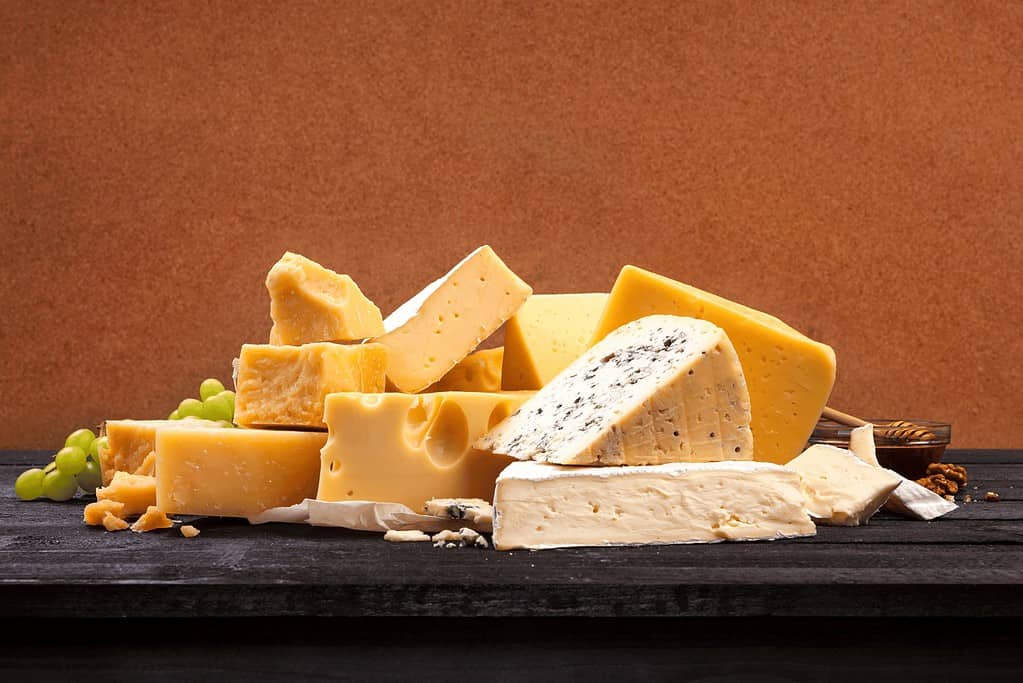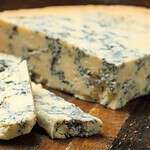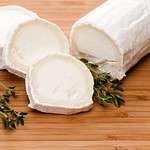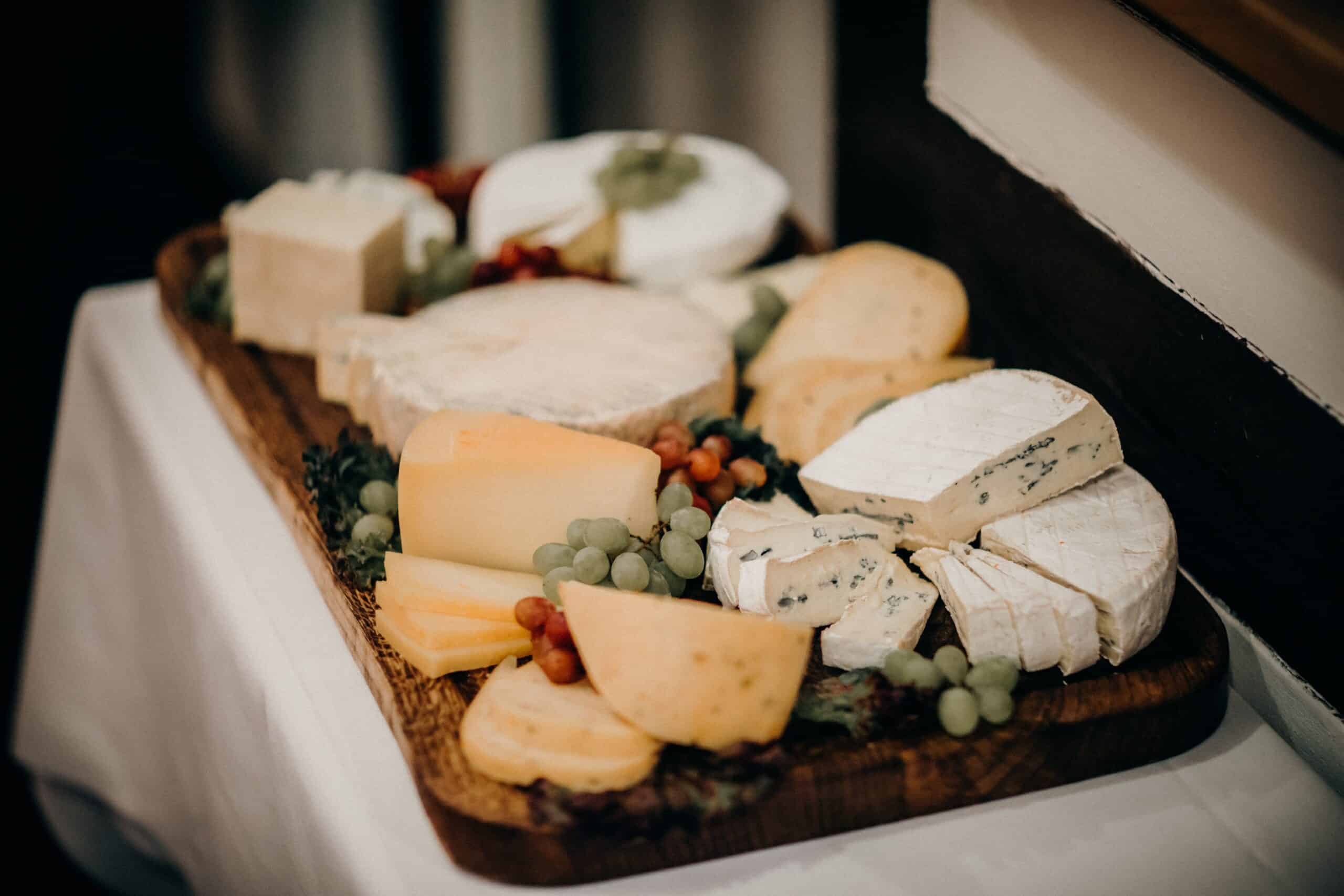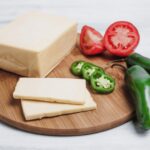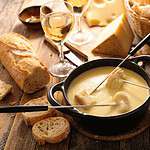Cheese is a dairy product that comes in a multitude of textures, flavors, and forms. It is created by coagulating the milk protein casein, typically from cow, goat, sheep, or buffalo milk. From fresh cheeses like mozzarella to aged varieties such as Parmesan, cheese is as diverse as it is unique, with its character being shaped by specific strains of bacteria or molds used during the aging process.
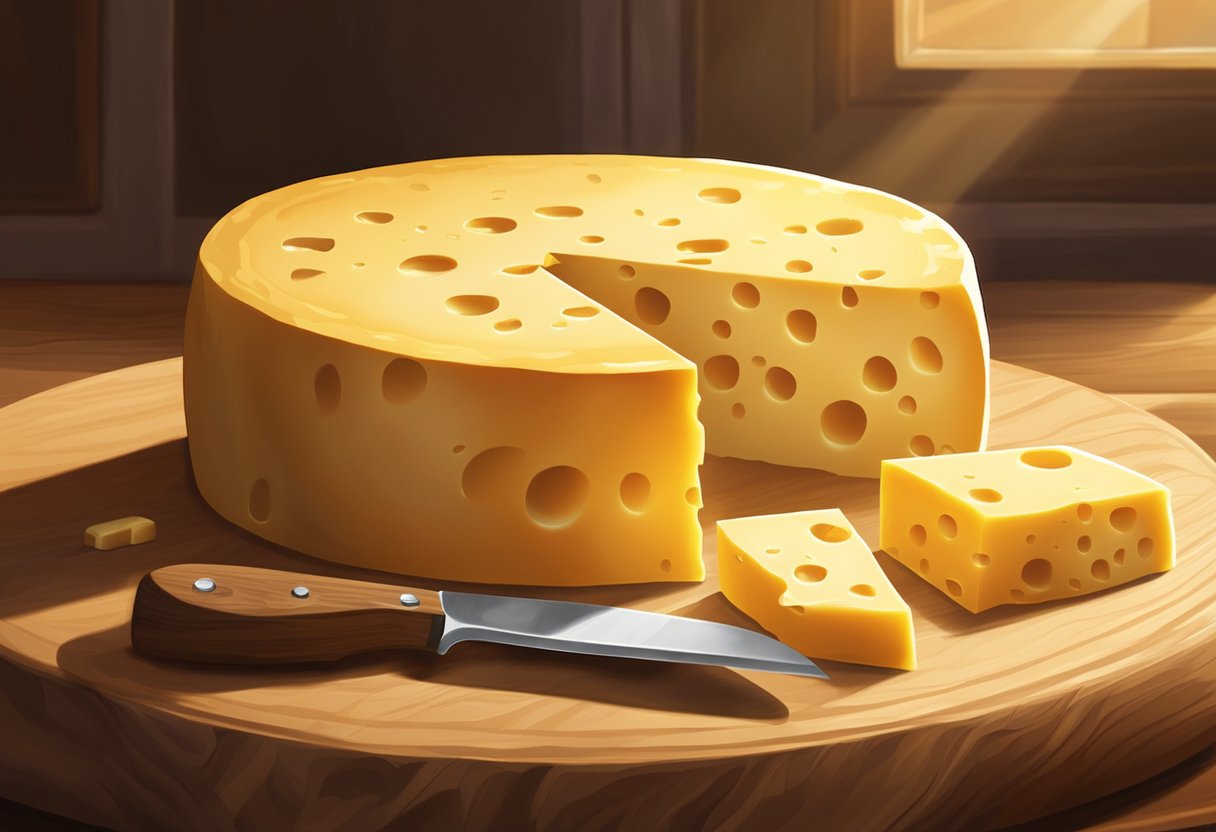
The production of cheese is both an art and a science, involving complex processes that transform simple milk into a vast array of cheeses. The methods of cheese production have evolved over thousands of years, originating from rudimentary forms to the sophisticated techniques of the modern cheese industry. Today, cheese remains a staple in diets around the world, not only for its flavor but also for its nutritional value, providing protein, calcium, and several essential vitamins.
Cheese has become embedded in cultural traditions worldwide, enjoying a place in culinary practices, folkways, and even in the economy as a significant agricultural product. When selecting cheese, one considers not only the type but also the region of origin, the aging and ripening processes involved, and the appropriate preservation methods to maintain its quality. Each choice offers a distinct taste experience and nutritional profile.
Key Takeaways
- Cheese is a versatile dairy product made by coagulating milk protein.
- The cheese-making process has a rich history and varies widely across different types and textures.
- Cheese is culturally significant and valued for its nutritional content, diverse flavors, and culinary uses.
History of Cheese
Cheese has an ancient and varied history that traces back thousands of years across multiple civilizations. We’ll outline its origins and development throughout the ages.
Cradle of Cheese Making
The story of cheese begins as far back as 8000 BCE, with sheep herding societies in Europe and the Middle East. Evidence suggests that Greece and Roman civilization played pivotal roles in early cheese production, with the Greeks having a word for cheese (τυρός) as early as 2300 BCE. Documentation from these ancient societies reveals that cheese made its way into politics, religion, and daily life.
Cheese Evolution Over Time
Over centuries, cheese-making techniques spread and diversified leading to the rich variety we celebrate today. In France, the word fromage became synonymous with artisanal cheese, thanks to a burgeoning culture of gastronomy. Similarly, the Spanish term queso captures the essence of the Spanish and Latin American cheese-making traditions. Cheese became a staple across Europe, with countries such as the Netherlands and Italy developing iconic cheeses—Gouda and Parmigiano-Reggiano, respectively.
The Irish also have a storied history with cheese, adapting their lush pastures into a robust cheesemaking tradition that endures. Each region’s unique environment, cultures, and innovations contribute to the vast array of cheeses we have today.
Cheese Production
In cheese production, we initially source high-quality milk and apply specific processes to transform it into a wide variety of cheeses. Each step is crucial, from milk sourcing to the pressing of cheese molds, to define the texture and flavor of the finished product.
Milk Sourcing
We obtain milk for cheese making from various animals, including cows, sheep, goats, and buffalo. The choice of milk is pivotal because it affects the cheese’s flavor, texture, and nutritional content. Each animal’s milk presents unique fat contents and flavor profiles that influence the cheese’s characteristics.
Curdling Process
The curdling process involves adding lactic acid-producing bacteria to the milk, which ferments the lactose, producing acid. This acidification leads to a sour taste and sets the stage for coagulation. After sufficient acidification, we introduce rennet or another coagulation agent, containing enzymes which solidify the milk into a gel-like state. This separation forms the foundation for curds and whey.
Separating Curds and Whey
Once the curdling process is complete, we cut the curd to help separate it from the whey. The size of the cut curds determines the cheese’s moisture content – smaller curds typically lead to harder cheese varieties. We continuously cook and stir the curds to encourage whey expulsion and curd firming. This careful process ensures that only the desired amount of whey remains with the curds.
Cheese Molding and Pressing
After the curds have been separated, we transfer them into molds. These molds give the cheese its shape and allow further whey drainage. By pressing the curds, we expel remaining whey and start the cheese aging process. Pressing time and weight vary, depending on the type of cheese we aim to produce. This step is crucial to achieve the desired texture and to solidify the shape of the cheese.
Types of Cheese
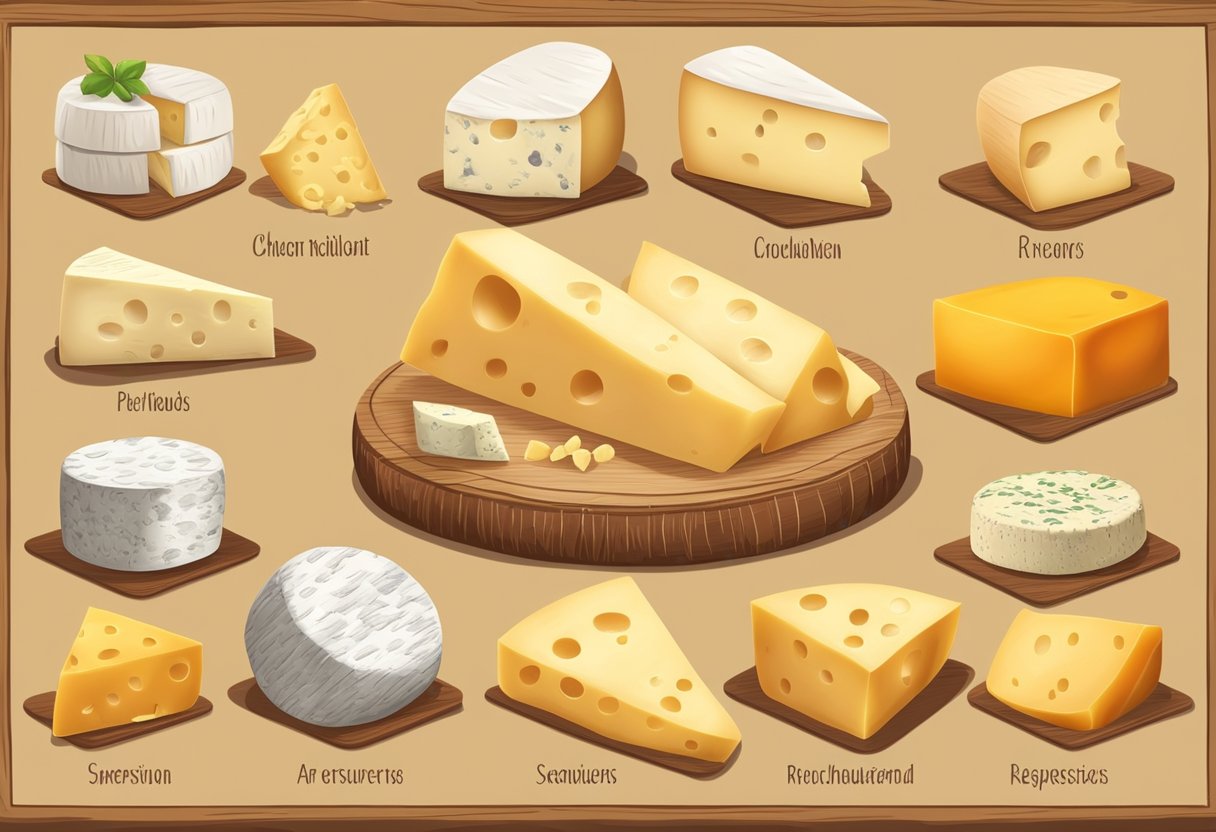
Different types of cheese offer a variety of textures, flavors, and culinary uses. We categorize cheese into groups, each with its own characteristics and renowned examples.
Soft Cheeses
Soft cheeses are characterized by their creamy texture and can have a mild to tangy flavor. Notable soft cheeses include:
- Brie: A rich, creamy cheese with an edible white rind.
- Camembert: Similar to brie but with a deeper, earthier flavor.
- Roquefort: A type of blue cheese from France with a moist, crumbly texture.
Hard Cheeses
Hard cheeses are aged longer, resulting in a firmer texture and often a more intense flavor. Some of the well-known hard cheeses are:
- Cheddar: Ranges from mild to extra sharp, with a rich and sometimes nutty flavor.
- Parmesan (Parmigiano-Reggiano): Known for its granular texture and sharp, nutty taste.
- Gruyère: A smooth-melting cheese with a slightly sweet, complex flavor.
Fresh Cheese
Fresh cheeses are unaged and usually have a mild taste and a soft, moist texture. Popular fresh cheeses include:
- Feta: A brined cheese from Greece, known for its crumbly texture and tangy flavor.
- Mozzarella: Often used on pizzas, it has a mild flavor and stringy texture when melted.
Processed Cheese
Processed cheeses are made by combining cheese curds with other ingredients to achieve desired flavors and meltability. They are generally shelf-stable and uniform in taste.
- American cheese: A common example with a smooth texture and mild flavor.
- Provel: A combination of cheddar, Swiss, and provolone, creamy when melted.
Aging and Ripening
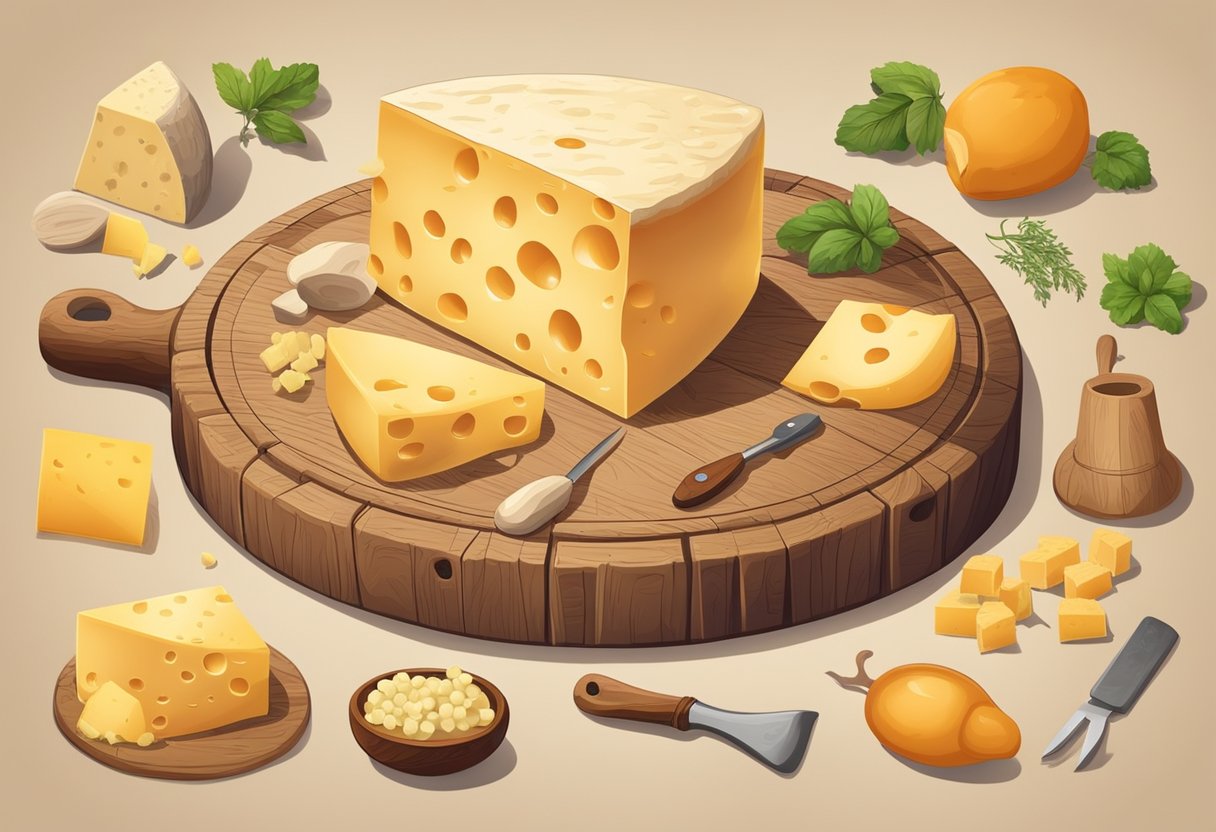
As we explore the intricacies of cheesemaking, it’s vital to understand that the aging and ripening are crucial steps that impart distinct characteristics to cheese. This transformative phase encourages the development of rich flavors and desirable textures that are synonymous with aged varieties.
Aging Process
The aging process, commonly known as maturation, involves holding cheese under controlled conditions for a period that can last from a few days to several years. During this time, a series of biochemical reactions occur, influencing the cheese’s ultimate flavor and texture.
- Temperature: Typically between 35°F and 55°F
- Humidity: Usually kept at 80% to 95%
- Time: Varies widely, from a few weeks to several years
- Turning and Cleaning: To prevent molding and ensure even maturation
Curing is a term often associated with this process, where cheeses are sometimes washed, brushed, or turned by hand. For example, cheeses like Gruyère are routinely rubbed with salt, which aids in the formation of a rind and prevents spoilage by undesirable microbes.
Effect of Aging on Flavor and Texture
As cheese ages, it undergoes a remarkable transformation in both flavor and texture.
- Development of Flavor Compounds: Enzymatic reactions produce molecules like amino acids and propionic acid, which contribute to the distinct nutty flavor in Swiss-type cheeses.
- Texture Modification: The breakdown of fats and proteins affects textural attributes, leading to a transition from creamy to crumbly as seen in aged cheddar.
Molds also play a significant role during the ripening of certain cheeses. For instance, Penicillium roqueforti is introduced into blue cheese to create its characteristic veins and bold, tangy taste. These beneficial molds are essential in developing complex flavors and are a hallmark of many classic cheeses.
Cheese Properties
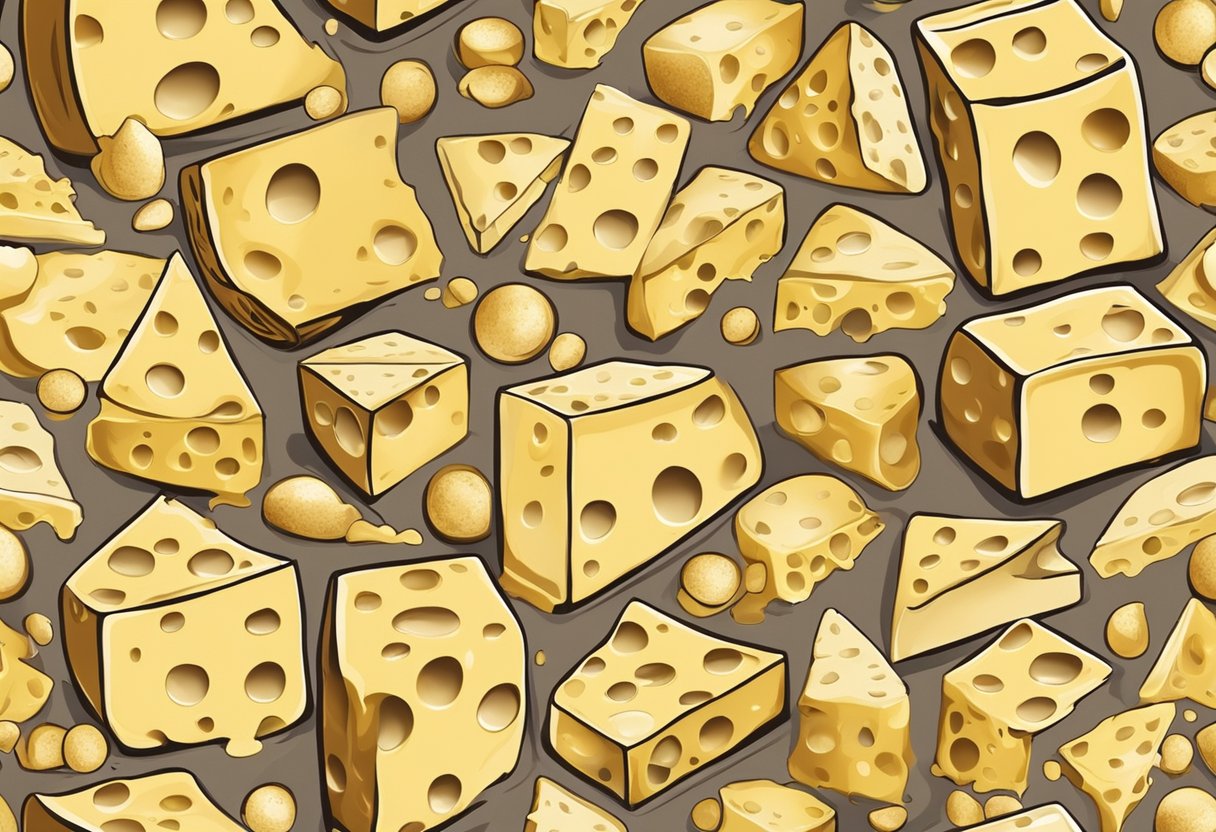
When we examine cheese, its distinct characteristics become evident through its flavor profiles, texture variations, and fat and moisture content.
Flavor Profiles
The flavor of cheese is influenced by various factors such as age, origin, and the type of milk used. The presence of fatty acids contributes to a wide array of flavors, from the sharpness in cheddar to the pungency of blue cheeses. We categorize flavors in terms such as:
- Sweet: Often found in fresh, young cheeses
- Sharp: Typically associated with aged cheeses
- Earthy: Common in cheeses with natural rinds
- Pungent: Characteristic of blue cheeses with blue veins
Texture Variation
Cheese textures can range from the creamy softness of brie to the grainy hardness of Parmesan. Proteins and fat play significant roles in texture, often determined by moisture content. We recognize several texture categories:
- Soft cheese: High moisture, spreads easily
- Semi-soft cheese: Less moisture, sliceable
- Hard cheese: Low moisture, often grated
- Blue-veined cheese: Feature veins of mold that contribute to a distinctive texture
Fat and Moisture Content
The fat and moisture content in cheese are determining factors in both texture and flavor. High-fat cheeses tend to be more flavorful and creamy, while low-fat options may be firmer and less rich. Here’s a quick overview:
- Fat content: Impacts creaminess and flavor intensity
- Moisture content: Helps determine the hardness or softness of the cheese
| Cheese Type | Fat Content | Moisture Content |
|---|---|---|
| Soft Cheese | High (creamier) | High (softer) |
| Hard Cheese | Varied | Low (firmer) |
| Blue Cheese | Varied | Medium (crumbly) |
In understanding these properties, we gain insight into the vast world of cheese and how it can be enjoyed in various culinary contexts.
Health and Nutrition
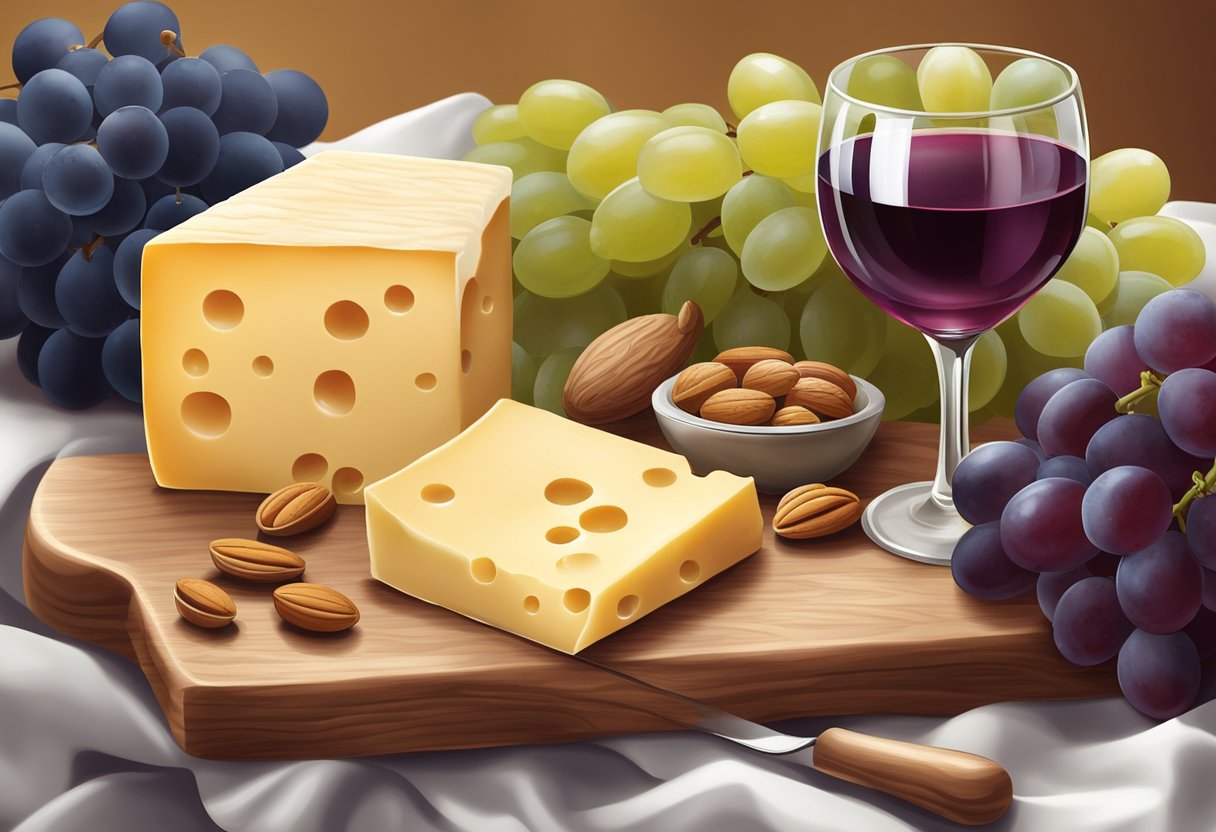
In this section, we’ll explore cheese’s nutritional values and the dietary considerations associated with its consumption. We’ll discuss its components such as calcium and casein, and we’ll touch upon its impact on health, including implications for cardiovascular disease.
Nutritional Values
Cheese is a rich source of essential nutrients that are beneficial for our health. It contains high levels of calcium and phosphorus, vital minerals for maintaining strong bones and teeth. Depending on the variety, cheese can also provide a good amount of protein, particularly casein, which is the main protein found in dairy foods. Here is a brief table summarizing the key nutrients typically found in a 100g serving of cheddar cheese:
| Nutrient | Amount in 100g |
|---|---|
| Calcium | 721 mg |
| Phosphorus | 512 mg |
| Sodium | 621 mg |
| Cholesterol | 105 mg |
| Protein | 25 g |
Dietary Considerations
When incorporating cheese into our diets, we must consider certain aspects such as sodium and cholesterol content, which could affect cardiovascular health if consumed in excess. The American Heart Association recommends limiting saturated fats, which some cheeses contain in higher amounts. This can contribute to higher cholesterol levels and an increased risk of cardiovascular disease.
Moreover, while cheese can be a valuable component of our diet, providing us with essential nutrients, those with a dairy intolerance or allergy should avoid it to prevent adverse reactions due to the presence of casein, a milk protein. Additionally, we need to be mindful of the calorie content in cheese, as it can be calorie-dense, which may impact weight management.
In terms of specific diets, such as vegetarian or low-carb, cheeses may fit well, but one should always check for suitability, particularly in the case of cheeses that may use animal-derived rennet or have higher carbohydrate content, respectively.
Cultural Significance
Cheese has a profound influence on culinary traditions and regional identities across the globe. Its versatility and variety underline its importance in different cultures.
Cheese in Cuisine
We find cheese deeply ingrained in many culinary traditions. For instance, French cuisine celebrates cheeses such as Brie and Camembert, which often feature on cheeseboards alongside fruits and nuts. Italian dishes like lasagna and pizza rely heavily on cheeses like mozzarella and ricotta to achieve their signature flavors and textures.
In Swiss meals, cheese is a staple, with fondue and raclette serving as communal dishes that celebrate the rich cheese-making heritage of the region. The Greeks are renowned for their feta and halloumi, the latter of which is a grilling cheese that boasts a robust texture and a salty flavor profile.
| Region/Cuisine | Cheese Types |
|---|---|
| French | Brie, Camembert |
| Italian | Mozzarella, Ricotta, Parmesan |
| Swiss | Emmentaler, Gruyère, Fondue Cheeses |
| Greek | Feta, Halloumi |
Regional Cheese Varieties
France also gives us roquefort, a blue cheese known for its strong aroma and flavor, while Italy is the home of parmesan — essential for topping pasta dishes and adding umami to various recipes. Havarti originates from Denmark and is known for its creamy texture and mild taste, making it a versatile component in sandwiches and as a snack.
The pungent Limburger, famous in Germany and Belgium, distinguishes itself with its strong smell. Switzerland‘s contribution extends to its nutty Gruyère and the smooth-melting Emmentaler. Moving eastward, paneer, integral to many Indian dishes, is celebrated for its firm texture and its ability to soak up flavors.
Greek yogurt, often comparable in texture to some soft cheeses, pairs well with various herbs and honey, showcasing the breadth of dairy products used in regional cuisine.
| Country | Cheese Varieties |
|---|---|
| Denmark | Havarti |
| Germany | Limburger |
| Belgium | Limburger |
| India | Paneer |
| General | Cottage Cheese, Cream Cheese, Goat Cheese, Yogurt |
Our exploration of cheese in various cultures underscores its pivotal role in shaping food heritage and regional eating habits.
Cheese Selection and Use
Selecting the right cheese and using it appropriately can enhance the flavor profile and overall experience of a dish. We will discuss optimal pairings with other foods and guide you through their use in cooking and preparation.
Pairing with Other Foods
When pairing cheese with other foods, balance is key. We consider the intensity and flavor of the cheese alongside potential partners. For instance:
- Strong cheeses: These pair well with bold-flavored accompaniments such as pickled vegetables or a robust red wine.
- Mild cheeses: These are best complemented by subtle flavors like those found in delicate white wines or light beers.
A simple table to help with pairings:
| Cheese Type | Food Pairing | Beverage Pairing |
|---|---|---|
| Soft, creamy | Fruit, crackers | Champagne |
| Hard, aged | Nuts, honey | Full-bodied reds |
| Blue-veined | Sweet jams, dark bread | Dessert wines |
Adding herbs can enhance the natural flavors of the cheese during the pairing process.
Use in Cooking and Preparation
We approach cooking and preparation with an understanding of cheese behavior under heat. Different cheeses react in varying manners:
- Melting cheeses: Ideal for sauces and gratins; we look for gooey, stretchy textures.
- Non-melting cheeses: Best crumbled or used in salads, as they hold their structure.
Incorporating vinegar in cheese-based dressings can provide a tangy contrast that accentuates the cheese’s richness. When preparing cheese-focused dishes, we work closely with a cheesemonger or cheese pro to select the best options for the intended application.
It is also important to remember that cheese can be the star of a dish or play a supporting role, so we select the quantity and variety accordingly to achieve the desired effect.
Cheese Industry
In this section, we explore the various facets of the cheese industry, encompassing the methods of production, the diversity in artisanal offerings, and the strategies behind marketing and distribution.
Commercial Production
Our knowledge of commercial cheese production centers around the systematic approach to manufacturing that enables the provision of cheese on a massive scale. Large-scale producers typically use pasteurized milk to ensure safety and consistency in their products. A database or list of cheeses is often maintained by these producers to track the types of cheeses made and their respective processes. The stages of commercial production include:
- Milk Standardization: Adjusting the milk composition for uniform quality.
- Pasteurization: Heat-treatment to eliminate pathogens.
- Curdling: Adding rennet to milk to form curds.
- Curd Treatment: Cutting, cooking, and washing curds to develop the desired texture.
- Pressing and Molding: Forming the cheese shape and expelling excess whey.
- Aging (Ripening): Storing cheeses under controlled conditions to develop flavor profiles.
Artisanal and Farmhouse Cheeses
Our understanding of artisanal and farmhouse cheeses conveys a more hands-on approach, where small-scale producers place an emphasis on traditional methods and local ingredients. These cheeses are often made from unpasteurized or thermalized milk, which can impart complex flavors but also require careful handling to ensure safety. Patterns in this sector exhibit:
- A diverse range of unique flavors and textures.
- A strong connection to local dairy sources and regional cheese-making traditions.
Cheese Marketing and Distribution
In cheese marketing and distribution, we leverage a variety of routes to ensure that cheese reaches consumers effectively. Key strategies include:
- Branding: Establishing a recognizable image for different cheeses.
- Packaging: Utilizing designs that maintain cheese quality and appeal to consumers.
- Distribution Channels: Working with retailers, specialty stores, and online platforms to widen market reach.
Our grasp on this subject shows that the cheese industry skillfully balances the demands of high-volume production with the artistry of specialized cheese-making, ensuring a broad array of choices for consumers worldwide.
Cheese Preservation
Maintaining the quality and extending the shelf life of cheese involves specific storage techniques and processes. We ensure the longevity of this dairy product while retaining its flavor and safety.
Storage Techniques
Temperature Control: We store cheese at temperatures between 35°F and 45°F, ideally in a refrigerator or a cheese cave, to slow bacterial growth and preserve texture. Cheese should be kept away from other foods to prevent absorption of foreign odors.
-
Humidity Control: A relative humidity of 85% is optimal for most cheeses to prevent drying out. We use specialized cheese paper or airtight containers for storage to maintain appropriate moisture levels.
-
Processing Influence: The methods used during cheese processing, such as pasteurization or the addition of preservatives, can impact the storage requirements and shelf life of the cheese.
Extending Shelf Life
Proper Wrapping: We wrap cheese in wax paper, cheese paper, or aluminum foil to allow it to breathe while minimizing exposure to air, which can lead to drying or mold growth.
-
Fermentation Control: By managing the level of fermentation in cheese creation, such as halting the process at the right time using temperature control, we extend cheese shelf life by preventing over-ripening.
-
Rennet Addition: Incorporating rennet in the cheese-making process aids in curdling the milk more efficiently, resulting in a firmer cheese with a potentially longer shelf life when stored correctly.
Frequently Asked Questions
In this section, we address some common inquiries regarding the consumption of cheese, its nutritional impacts, and its role in our diets.
What are the nutritional impacts of consuming cheese?
Cheese is a significant source of calcium, protein, and fat. It also provides essential nutrients like vitamin B12, phosphorus, and zinc. However, the nutritional impacts vary depending on the type of cheese and the amount consumed.
Can cheese contribute to weight gain?
Cheese is calorie dense and high in fat, so consuming it in large quantities may contribute to weight gain. The key is moderation and incorporating it into a balanced diet.
How much cheese is advisable to consume daily?
The amount of cheese one should consume daily varies based on individual dietary needs and health goals. Generally, a portion size of 1-2 ounces (30-60 grams) may fit into a balanced diet.
What are the benefits and drawbacks of eating cheese?
The benefits of eating cheese include its high calcium content which is important for bone health, and the presence of proteins which are essential for body repair and maintenance. Drawbacks include its high saturated fat content, which can contribute to heart disease if consumed in excess.
Are there benefits to eating cheese before bedtime?
Eating cheese before bedtime is unlikely to directly benefit sleep. Some types of cheese contain tryptophan, an amino acid that can help in the production of melatonin, a hormone involved in the sleep cycle. However, eating cheese at night could lead to indigestion for some people.
What are the main ingredients in the production of cheese?
The main ingredients in cheese production are milk, cultures (bacteria), enzymes like rennet, and salt. The type of milk and the specific strains of cultures used can influence the flavor and texture of the cheese.

